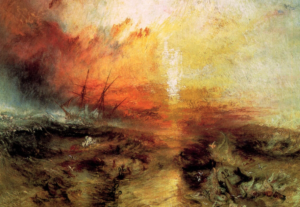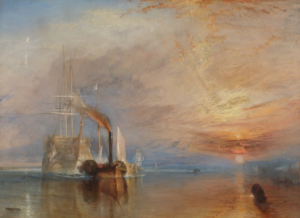 JMW Turner’s heart-stopping maelstroms of sea and steam and smoke made him a true visionary of his age from the most devastating depiction of the slave trade ever to an erotically-charged shipwreck. This exhibition presents Turner as a passionate and engaged painter of modern life. It shows how alive he was to the liberations and oppressions of his revolutionary age. Born in London in 1775, into a world ruled by aristocrats and monarchs where the horse was the fastest thing on earth, Turner lived to see the coming of trains, steamships, political reform and photography – and the abolition of the slave trade. He adores the modern world in a way no one can today.
JMW Turner’s heart-stopping maelstroms of sea and steam and smoke made him a true visionary of his age from the most devastating depiction of the slave trade ever to an erotically-charged shipwreck. This exhibition presents Turner as a passionate and engaged painter of modern life. It shows how alive he was to the liberations and oppressions of his revolutionary age. Born in London in 1775, into a world ruled by aristocrats and monarchs where the horse was the fastest thing on earth, Turner lived to see the coming of trains, steamships, political reform and photography – and the abolition of the slave trade. He adores the modern world in a way no one can today.  A label reminds us that the smoke rising in dark grey majesty from river steamers in his c1835-40 canvas The Thames Above Waterloo Bridge is full of catastrophic carbon. But, for Turner, that smoke is sublime, a blue-tinged shadow sculpted against white mists. This artistic radicalism is what enabled Turner to paint the Slave Ship – to imagine a historical event as if he was there. Its real meaning is revealed in the most unexpected way. I’d never noticed before how similar the Slave Ship is to his beloved masterpiece, The Fighting Temeraire, lent by the National Gallery. Both are burnished by his most heightened colours. Both depict an era that has gone. The Fighting Temeraire is a pale ghost ship pulled by a brassy steamboat: one of the last survivors of the Battle of Trafalgar being towed to oblivion. But Turner demands we remember it, with national pride. In the Slave Ship, he uses the same genius to preserve the most shameful of British memories.
A label reminds us that the smoke rising in dark grey majesty from river steamers in his c1835-40 canvas The Thames Above Waterloo Bridge is full of catastrophic carbon. But, for Turner, that smoke is sublime, a blue-tinged shadow sculpted against white mists. This artistic radicalism is what enabled Turner to paint the Slave Ship – to imagine a historical event as if he was there. Its real meaning is revealed in the most unexpected way. I’d never noticed before how similar the Slave Ship is to his beloved masterpiece, The Fighting Temeraire, lent by the National Gallery. Both are burnished by his most heightened colours. Both depict an era that has gone. The Fighting Temeraire is a pale ghost ship pulled by a brassy steamboat: one of the last survivors of the Battle of Trafalgar being towed to oblivion. But Turner demands we remember it, with national pride. In the Slave Ship, he uses the same genius to preserve the most shameful of British memories.
Turner’s Modern World is at Tate Britain from 28th of October to 7th of March
https://www.tate.org.uk/whats-on/tate-britain/exhibition/turners-modern-world
